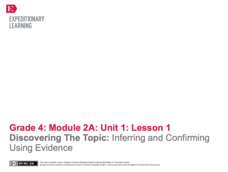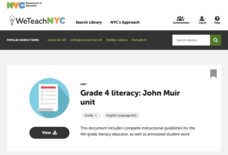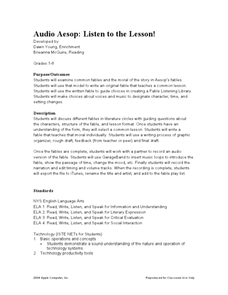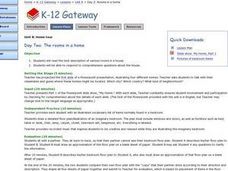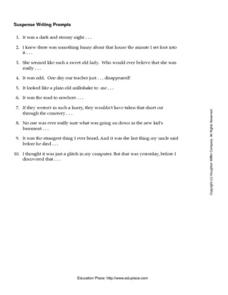EngageNY
Discovering the Topic: Inferring and Confirming Using Evidence
Allow your class to figure out what they will be studying through an inquiry-based anticipatory set that involves analysis of mystery documents and practice with making inferences. The lesson plan document includes a detailed description...
Curated OER
Let's Put You in a Louisiana University
Considering a college search project? After picking a possible career choice, and determining if that career needs a technical college or university education, individuals examine a wide variety of sources and select three schools that...
Bulgarian Creative Writing Competition
Creative Writing Workshop
Looking for suggestions on how to organize a creating writing workshop? For topic suggestions appropriate for various grade levels? Check out a resource packet, designed for English language arts instructors, that is packed with ideas...
Curated OER
Where in the United States Are We?
Fifth graders collaborate with another fifth grade classroom while learning about various locations in the United States. This is a telecollaborative video conferencing project that is designed for students studying United States history...
Curated OER
Semicolon vs. Colon...And What is a Comma Splice?
Designed originally for higher education, this PowerPoint could also be used to introduce your high schoolers to the semicolon, colon, and comma splice. The texts do not contain pictures or graphics; instead, they present information in...
New York City Department of Education
Grade 4 Literacy: John Muir Unit
Learn how to correctly analyze and score a written performance task. Example work shows annotated think alouds for grading. Teachers also have access to graphic organizers for helping writers succeed,
Newspaper Association of America
Using the Newspaper to Teach the Five Freedoms of the First Amendment
Of all the amendments found in The Bill of Rights, the First Amendment contains some of the most important freedoms for American citizens. A unit plan on the First Amendment features interactive lesson plans designed to teach about those...
Curated OER
Say Hi to Haibun Fun
Students examine the Japanese writing form of Haibun. They identify the elements of Japanese prose and poetry, analyze a haibun for writing devices, complete a graphic organizer, and compose an original haibun as a form of journal keeping.
Curated OER
Audio Aesop: Listen to the Lesson!
Aesop's Fables are the focus of this language arts lesson. Young philosophers study and discuss the morals found in the most famous of Aesop's Fables. They write an original fable that teaches a common moral. A "Fable Listening Library"...
Curated OER
Sharing is Caring
By engaging in an arts-based activity, 2nd graders explore peace in the classroom. They listen to the story The Rainbow Fish, then create their own fish to hang in the classroom. They write three things that make them happy on their...
Curated OER
Writing Fables
Young scholars write their own fables. In this writing fables lesson, students use handheld computers to write a fable. The class designs a spreadsheet to organize common elements of fables. Young scholars also edit each others' work.
Curated OER
The Rooms in a Home
Enhance your foreign language students' skills to describe a house. After reading a description of rooms in a house in their target language, they work to answer corresponding questions correctly. Additionally, they view a PowerPoint...
Curated OER
Dr. Seuss - Make Time for Rhymes
Read the story Green Eggs and Ham to practice phonemic awareness, rhyming, and writing skills with emerging readers. They will match oral words to printed words, create a graphic organizer, and the use rhyming words in an original...
Perfection Learning
I Know Why the Caged Bird Sings
A revolutionary work of literature requires a revolutionary assessment project. A series of activities on Maya Angelou's I Know Why the Caged Bird Sings includes discussion questions, a plot synopsis, and a selection of both short and...
Curated OER
Storyboards: The Director's Map to a Video Project
Class groups collaborate to produce the storyboard for their video project. After determining the sequence of scenes, the camera angles, and characters in each scene, each group member is assigned a number of scenes to illustrate. When...
Scholastic
Story Board
Invite your pupils to tell and show what happened in a story that they read by filling out this organizer. Using images and words, kids can fill out the six panels provided here to demonstrate understanding of the sequence of events and...
Curated OER
Kip Pix Studio Deluxe
After reading The Sign of the Beaver, learners utilize Kid Pix Studio Deluxe to draw a picture from one scene in the story. They also compose a description to accompany their scene. A minimum of two paragraphs must be written, using at...
K12 Reader
Ben Franklin
Readers are asked to use the provided graphic organizer to list the main idea and supporting ideas in a passage about the inventions of Benjamin Franklin.
Curated OER
Developing an Outline
A lot of writers don't like creating an outline before writing the first draft of their paper. Introduce them to what an effective and organized outline looks like with this presentation. Designed for higher education, you could easily...
Portland Public Schools
Narrative Writing: Personal Narrative
Whether you need to supplement your narrative writing unit or you'd like to start from scratch, a thorough unit plan can be a helpful way to guide learners through personal narratives. The plan has complete learning goals and...
Houghton Mifflin Harcourt
Suspense Writing Prompts
"I don't know what to write about!" How often have you heard that lament? Here's a list of 10 prompts that provide a starting place for suspense stories.
Have Fun Teaching
Making Inferences (21)
Monstrous! But do not be afraid! These weird-looking creatures won't scare readers away from making inferences about what authors are trying to show, rather than tell their readers. Instead the toothy, bug-eyed aliens model the process...
Novelinks
The Little Prince: Blooms’ Taxonomy Questions
Question what you read with a lesson based on Bloom's Taxonomy. As kids read The Little Prince by Antoine de Saint-Exupéry, they formulate questions with cues from a graphic organizer, and answer them to work on critical thinking skills.
Houghton Mifflin Harcourt
Person to Person: Challenge Activities (Theme 4)
The world is a big place—discover it! A series of challenge activities designed to accompany Theme 4: Person to Person encourages learners to explore the world around them. Project-based activities promote research and writing skills in...


